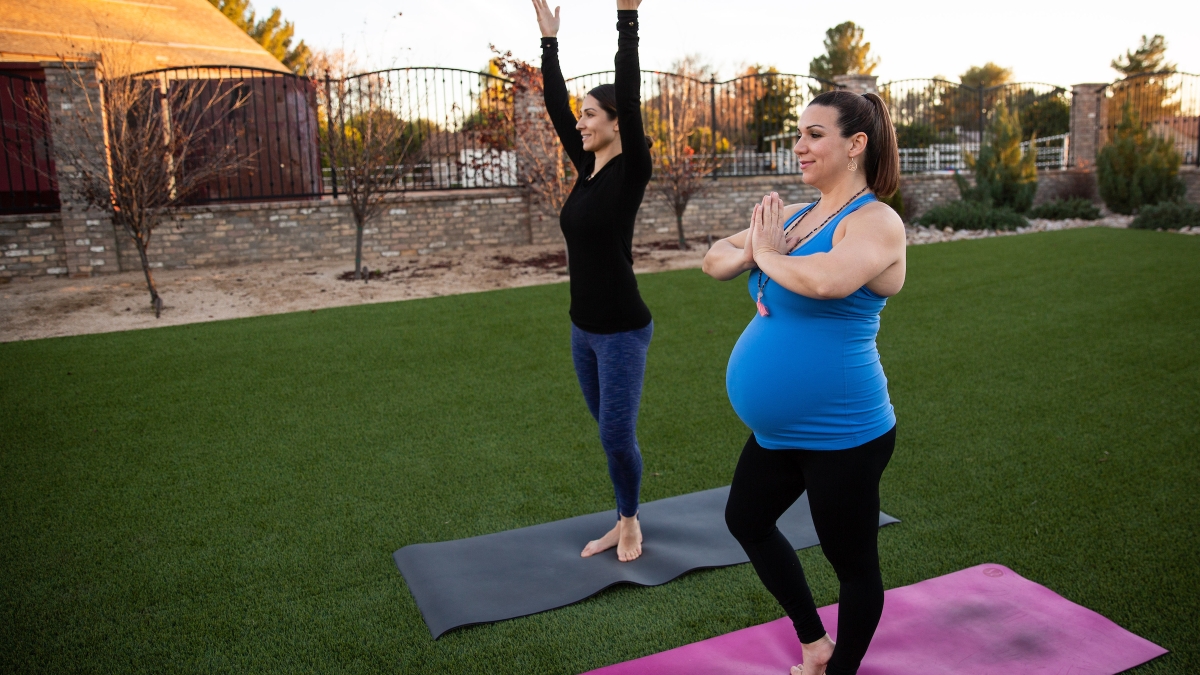Working on your fitness: Yoga for pregnancy and new moms
Latest national guidelines find that physical activity during pregnancy reduces the risk of excessive weight gain, gestational diabetes and symptoms of postpartum depression

Pregnancy is no walk in the park: Women can suffer sudden weight gain, nausea, fatigue, headaches and mood swings. And these symptoms aren’t just uncomfortable — they can prevent a soon-to-be mom from being physically active, a risk to both her and her unborn child’s health, as outlined in the latest updates to the national Physical Activity Guidelines.
Specifically, the guidelines found strong evidence that physical activity reduces the risk of excessive weight gain, gestational diabetes and symptoms of postpartum depression for pregnant women.
In the hopes of helping women overcome the physical hurdles of pregnancy and keep fit throughout, Arizona State University College of Health Solutions Associate Professor Jennifer Huberty and graduate student Jeni Matthews are hard at work on interventions to discourage sedentary behavior and develop more feasible exercises.
Getting moms moving
Six years ago, when Huberty learned a popular educational text message service for pregnant women didn’t have any messaging regarding the importance of physical activity during pregnancy, she saw an opportunity.
She and her research team partnered with the service and developed 160 text messages about physical activity in the hopes of getting pregnant women moving. What they found was that although women reported improved knowledge and awareness of physical activity, it didn’t necessarily mean they were sticking to a regular workout routine.
“When we looked at their trajectory of physical activity over time, women were increasing physical activity at first, and then right at about 28 to 32 weeks, it went straight down and then just leveled off,” Huberty said. “That’s because there’s this barrier they have, and it’s called pregnancy.”
There’s a period during pregnancy called “the honeymoon phase,” she explained, where during the second trimester, women feel great. Then, right at the 28th to 32nd week, the physical reality of being pregnant becomes an almost insurmountable obstacle to physical activity.
Video by Deanna Dent/ASU Now
In addition, Huberty said, “We often see that pregnant women who were active before pregnancy not only don’t do any activity during pregnancy, they sometimes don’t return to activity after pregnancy.”
That’s when it hit her: Maybe instead of asking moms to move more, they’d have more success asking them to sit less.
Huberty turned to ASU Associate Professor Matt Buman, whom she had previously collaborated with on an app geared toward discouraging sedentary behavior in veterans. About a year ago, the pair tailored the app for pregnant women with the goal of breaking up sedentary bouts — periods of prolonged sitting — by reminding the user to do things like get up and stretch every 10–15 minutes or take a short walk around the living room.
They conducted a small pilot study about a year ago to get feedback and have since incorporated what they learned into the app, tentatively called Just Move Mom for a future release, which is currently in a review process to earn NIH funding for further testing.
Mommy yogis
While activities like contact sports, jumping rope and sit-ups are either unsafe or impossible during pregnancy, Matthews is conducting a study to see if the less intense nature of yoga could make it a viable alternative not only to mitigate sedentary behavior but to help manage gestational weight gain.
Aside from yoga’s low-impact benefits, research has also shown that it can relieve certain symptoms associated with pregnancy, including lower back pain, fatigue, nausea and trouble sleeping.
“Because yoga is a lower-impact type of exercise, and because it may help women feel relieved of their symptoms, we’re hoping they’ll be more motivated to stick with it throughout their pregnancy,” Matthews said.
She and her team created a program of specific yoga postures for pregnant women, which they introduce to study participants over the course of a 12-week intervention. They’ll compare the results to a control group, which receives only pregnancy education information.
The program was designed for women to be able to participate throughout the duration of their pregnancy. Participants are enrolled anywhere from 12 weeks along to 24 weeks, meaning they’ll be anywhere from 24 weeks to 36 weeks upon completion. Because of this, Matthews and her team will be able to compare the effects of introducing the intervention at different points throughout pregnancy.
They’ll also be collecting data on birth outcomes to determine how the intervention affected the health of the baby. They hope to have results for study participants as early as May, and results for birth outcomes by the fall.
Though her study is focused on yoga’s effect on weight gain, Matthews points out that it has also shown to be effective at managing postnatal depression and PTSD, another research area of focus for Huberty.
Yoga for postnatal depression and PTSD
Eight years ago Huberty gave birth to a stillborn child at full term. Grief-stricken, she turned to yoga and found it helped ease some of her pain. Since then, she’s been committed to researching the healing effects of the practice for moms with postnatal depression and PTSD.
About 26,000 pregnancies a year end in stillbirths, Huberty said. “With those moms, sometimes we do see post-traumatic stress.”
It’s also common among mothers who have other complications, such as C-sections or babies who require care in the neonatal intensive care unit. Even among women with healthy pregnancies and deliveries, about 3 to 8 percent will still experience post-traumatic stress, just from the experience of giving birth.
Huberty is in the midst of a three-year study funded by the NIH that hopes to capitalize on the mindful, meditative aspects of yoga to help quiet the mind and reduce post-traumatic stress in new moms. She expects to report results in about a year.
“It’s very important that we’re thinking about managing and learning how to cope with the emotions that follow (pregnancy and child birth),” Huberty said. “A lot of times physicians are really quick to give a depression medication when these women aren’t necessarily depressed, they’re really just grieving.”
Top: Jeni Matthews, a doctoral researcher in the College of Health Solutions, works through specific prenatal yoga moves with yogi Deanna Frank in Gilbert, Arizona, on Jan. 19. By Deanna Dent/ASU Now
More Health and medicine

College of Health Solutions hosts visit from leading expert in genomic research
Some fortunate Arizona State University faculty, staff and students were able to gain valuable insights and perspective during a visit by one of the country’s leading figures in health and scientific…

Indigenous ASU research team recommends assistance for tribal members still reeling from COVID-19’s effects
When Matt Ignacio’s tribe, the Tohono O’odham Nation, donated $1 million to Arizona State University to support COVID-19 research, he applied for some of the money to understand and report any…

Tips for staying hydrated during Pat's Run and other outdoor activities
By Aidan Hansen Staying hydrated and listening to your body during outdoor exercise activities is crucial to one's health and safety, especially in warm climates. And with the average daytime high…